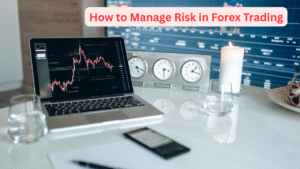 How to Manage Risk in Forex Trading: Protect Your Capital
How to Manage Risk in Forex Trading: Protect Your Capital
Learning How to Manage Risk in Forex Trading isn’t just an option — it’s a necessity. No matter how great your strategy or analysis, without controlling risk, you’re exposing yourself to potentially devastating losses.
Many beginners focus on trying to pick the “perfect” trade but ignore the fact that protecting your capital is the foundation of long-term success. After all, the goal isn’t just to make profits — it’s to stay in the game long enough to make consistent gains.
In this article, we’ll cover essential risk management techniques to help you trade Forex responsibly and confidently.
Why Is Risk Management So Important?
The Forex market is highly volatile and influenced by countless unpredictable factors like economic data releases, geopolitical events, and central bank decisions.
Even the most experienced traders can’t predict every move. That’s why managing risk—the possibility of losing money—is critical.
Proper risk management helps you:
- Limit losses to a small percentage of your account per trade
- Preserve capital for future opportunities
- Reduce emotional stress and impulsive decisions
- Build consistent, long-term profitability
Key Risk Management Strategies for Forex Traders
1. Set a Risk Percentage Per Trade
A common rule among professional traders is to risk no more than 1–2% of your account balance on any single trade.
For example, if you have a $10,000 account, risking 1% means you’re willing to lose $100 on a trade. This approach helps you survive losing streaks without wiping out your account.
2. Use Stop-Loss Orders
A stop-loss is an automatic order that closes your position if the market moves against you by a certain amount.
Stop-losses prevent large losses from unexpected moves and protect your capital.
When setting stop-loss levels, consider:
- Market volatility
- Support and resistance levels
- Your trading timeframe
3. Calculate Position Size Based on Risk
Position sizing is about determining how large a trade you can take given your stop-loss and risk tolerance.
Position size = Risk amount ÷ (Entry price − Stop-loss price)
Calculating position size ensures you don’t risk too much on any trade, especially when your stop-loss is wide.
4. Limit Leverage Usage
While brokers offer leverage to magnify gains, it also magnifies losses.
Using excessive leverage (e.g., 100:1 or more) is a fast way to blow your account.
Start with low leverage (e.g., 10:1 or less) until you gain experience.
5. Diversify Your Trades
Don’t put all your eggs in one basket.
Avoid risking too much on a single currency pair or correlated instruments. Spread your risk across different pairs or asset classes to reduce exposure.
6. Avoid Trading During High-Impact News (If You’re Inexperienced)
Economic announcements can cause sudden spikes and unpredictable moves.
Unless you’re an experienced news trader, avoid opening new positions before major news to reduce risk.
7. Keep an Emotional Check
Fear and greed often lead to poor risk decisions, like moving stop-losses or increasing trade size impulsively.
Make sure you stick to your risk management plan without exceptions.
How to Implement Risk Management: A Simple Example
Suppose you have a $5,000 account and want to trade EUR/USD.
- You decide to risk 1% per trade = $50 maximum loss
- Your analysis suggests placing a stop-loss 50 pips away from your entry
- You calculate position size accordingly (for example, trading 0.1 lots where each pip = $1)
If the trade hits your stop-loss, you lose $50 — a manageable amount that protects your account.
How to Manage Risk in Forex Trading: Final Thoughts
Risk management is the cornerstone of successful Forex trading.
By setting clear rules on how much to risk, using stop-losses, controlling leverage, and diversifying, you protect your capital and reduce emotional stress.
Remember, no strategy is perfect, but good risk management ensures you stay in the game long enough to become a consistently profitable trader.
You should Invest the time to learn and practice these risk controls — your future self will thank you.
How to Manage Risk in Forex Trading: FAQs
1. What is the safest risk percentage per trade?
Most traders recommend 1–2% of your account balance per trade.
2. Can I trade without a stop-loss?
It’s risky. Stop-losses are essential for protecting your capital from big losses.
3. How does leverage affect risk?
Leverage amplifies both profits and losses. Higher leverage means higher risk.
4. Should I risk the same amount on every trade?
Ideally, yes. Consistent risk per trade helps control losses and manage emotions.
5. How do I calculate my position size?
Position size = Risk amount ÷ (Entry price − Stop-loss price). Many brokers also offer position size calculators.
